On the Sunday, I was 'marked' to drive visiting 'Austerity' 0-6-0ST locomotive 'Cumbria'. There's more information about 'Cumbria' on the Furness Railway Trust Site here. I turned up early as 'Cumbria' and 'Sir Gomer' were booked to double-head a demonstration freight train departing Shackerstone at 08:45. I found 'Cumbria' and 'Sir Gomer' outside the shed, coupled together bunker to bunker. The fire in 'Cumbria' was being lit so I set about oiling round. Fortunately, 'Cumbria' is in 'as-built' state without mechanical lubricators on the framing and the mechanical drive that necessitates so access was not a problem and I was able to climb into the motion to attend to the eccentrics and big ends without difficulty. I've lamented before that I find the other 'Austerity Tank' I drive fairly regularly, 'Lord Phil' at Peak Rail, difficult to prepare because of the 'modernisation'.
Both engines were in steam in plenty of time but both engines needed to take water and Danny said we'd need coal after our freight train run. So, coupled together, the two engines trundled over to the water column on platform 2 road. We stopped so that 'Sir Gomer' could take water first and whilst he took water, we uncoupled. Because the freight train was stabled in the DMU siding, we had a bit of a shunt to undertake. 'Sir Gomer' went across to the DMU siding, attached the double-braked freight train and drew the whole train down to the North End, clear of the crossover to the single line. Meanwhile, we took water and Phil, the signalman, loosed us to the Section Signal. With the crossover reversed, 'Sir Gomer' propelled the whole train onto us, with Danny "on the floor" giving hand signals to Brian on 'Sir Gomer'.
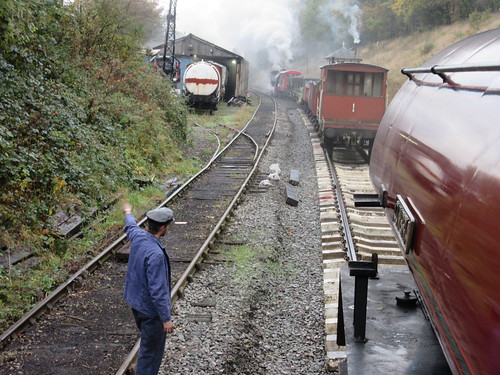 With Danny controlling the move, 'Sir Gomer' propels the freight train onto waiting 'Cumbria'.
With Danny controlling the move, 'Sir Gomer' propels the freight train onto waiting 'Cumbria'.
The goods train was coupled to us, uncoupled from 'Sir Gomer' and, with the crossover set normal again, 'Sir Gomer' moved north along platform 2 road, clear of the crossover. With the crossover reversed again, we then propelled the freight into platform 1. Finally, 'Sir Gomer' came across and coupled "on top of us".
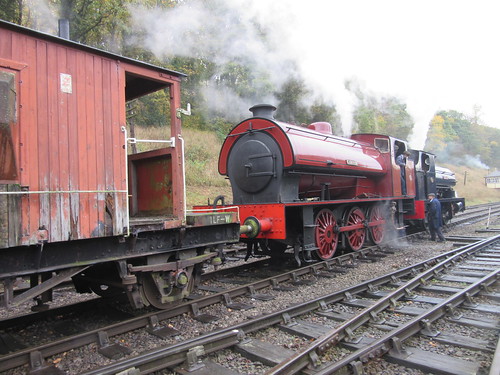 'Cumbria' and 'Sir Gomer' ready to leave Shackerstone with the 08:45 freight.
'Cumbria' and 'Sir Gomer' ready to leave Shackerstone with the 08:45 freight.
Once the Guard had arrived and checked the train, we were "Right Away" on time with Danny supervising firing by the cleaner, Jacob. As we passed the signal box, the signalman, Phil, showed the Single Line Staff to 'Sir Gomer' but handed it to me. In steam days, it was always the rearmost locomotive which carried the Staff.
Peak Rail has reversed this tradition so, when top-and-tailing there, it's the leading engine which carries the Staff.We made a slow departure - the limit is 5 m.p.h. over the crossover from platform 1, Dead Slow over the relaid track panels, then 10 m.p.h. up the bank until clear of the Barton Lane road bridge. We then picked up a bit of speed. At the two foot crossings, there are 'W' boards ('Whistle') and 'Sir Gomer' complied. In this area, there was a group of photographers trackside but there were various people waiting for us to pass at various places down the line.
 A group of photographers capture the 08:45 freight.
A group of photographers capture the 08:45 freight.
As you approach Market Bosworth there's an 'SW' board ('Sound Whistle' - I think the Great Western originally preferred this formulation) but 'Sir Gomer' didn't whistle. Then Danny shouted "Whistle!", so I did. It appeared that 'Sir Gomer's' whistle chain had become detached, leaving the engine mute. Although we were not booked to stop, Brian brought the train to a stand in the platform so that a whistle repair could be effected and, when the Guard gave the 'tip', both engines whistled and we set off for Shenton. For some time, there had been a 15 m.p.h. slack passing over the bridge near the south end siding, but this had recently been downgraded to a 5 m.p.h. limit. Once clear of this, we were able to hustle on to Shenton.
Leaving the two engines coupled together, we ran round our double-braked train (that is, a brake van on each end), so we didn't have to do the extra shunt which would have been needed to get a single brake van onto the other end of its train.
This used to be a question for shunters - simple loop, one engine, set of wagons, one brake van, what are the moves?Having used the Single Line Staff to work the points for us at the Shackerstone end of the loop, the Guard showed the staff to me, as I was now the leading engine, but handed it to 'Sir Gomer'. As soon as the Guard was "back in his box" at the rear of the train, he gave the "Right Away". Once we were clear of the speed restriction in Shenton Station, I was able to open 'Cumbria' up a little.
The arriving train stops with the brake van just outside the loop points. Van brake is applied and brake van is uncoupled. Engine draws wagons into station and sufficient wagon handbrakes are applied before engine uncouples, draws forward to headshunt, reverses round the loop to the brake van, attaches it and takes it forward round the loop to the headshunt, then propels the brake onto the waiting wagons. Brake van is attached to wagons, brakes set as required, engine uncouples, forward into headshunt, reverse around the loop until outside the loop points which are then set towards the wagons. Finally, engine moves forward onto the wagons. Job done!
We found her a rather noisy engine. Both injectors were very loud (and the one on the fireman's side wasted a lot of water). In full first valve with the gear notched up one notch (she went a bit 'off-beat' on two notches), there was a loud roar from the chimney - a mixture of the expected four discharges per revolution of the wheels and a continuous noise, possibly turbulence caused by the vacuum ejector or misalignment of the blast pipe. At least the row drowned out the occasional thumps and bangs from the axleboxes and big ends. But, having said that, she gamely hauled our train back to Shackerstone, where we arrived about 'right time'. We cautiously made our way into platform 1, passing the 'Collett Goods' which had 'hooked on' to the 4-coach Griddle Car set in platform 2, ready to work the ten o'clock departure.
We uncoupled from 'Sir Gomer', leaving Brian to propel our train back through platform 1 and stable it in the DMU siding, whilst we kept out of the way on the 'back road' at the north end. 'Sir Gomer' returned, picked up the 4-coach 'Set 2' from the 'front road' at the north end and positioned it in platform 1 ready for the eleven o'clock hauled by 'Dinmore Manor'. Once the coaching stock was removed, we were able to shunt across to the 'front road' to await coaling, after which there was time for a bit of breakfast before our next duty.
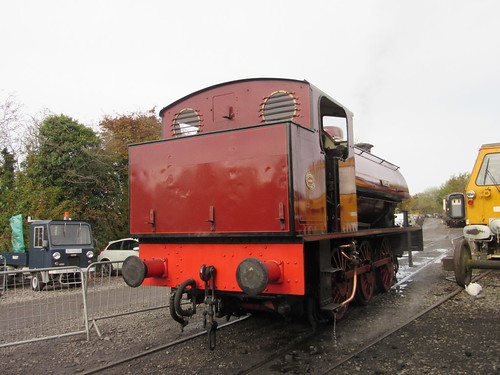 3794 'Cumbria' awaiting coaling.
3794 'Cumbria' awaiting coaling.
Passenger trains were booked to depart Shackerstone hourly. The 'Collett Goods' was back in good time and enthusiasts scuttled across from the train they'd just arrived on to platform 1 for another trip down the line on the eleven o'clock departure. Once 'Dinmore Manor' had left with its train, we were able to shunt via platform 1 to couple onto the head of the 'Griddle Car Set' in platform 2 ready to work the 12 o'clock.
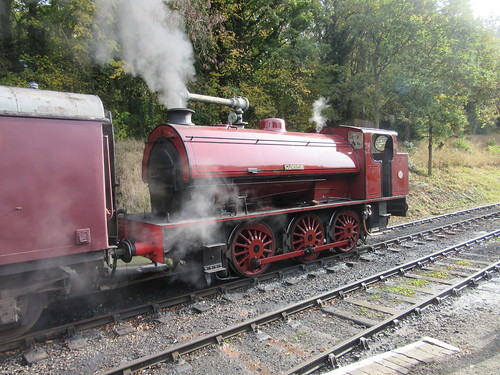 'Cumbria' ready to take the 12 o'clock departure.
'Cumbria' ready to take the 12 o'clock departure.
We were a little late away. Although we had a good run down to Shenton, we were still a couple of minutes late at Shenton, as the Guard pointed out. We ran round smartly and had another good run back to Shackerstone, this time, of course, chimney leading and ran into platform 2 about right time. The 'Collett Goods' was ready to take the one o'clock out of platform 1 and, when that departure had left, 'Dinmore Manor' was able to take her place at the other end of the train we'd brought in.
Dinmore Manor was first restored to traffic in 1995 at Tyseley Locomotive Works. When she was first steamed, they were keen to try her out looking for any problems before she left Birmingham, and I was fortunate enough to have her for a few hours whilst we ran up and down the demonstration line continuously. I'd been told that, to celebrate the event, I could allow Museum Volunteers to have a footplate ride on this "fresh off" (the term for a locomotive emerging from the works after overhaul) and it was a very jolly time. Then, she was in green livery but she now sports unlined black with the original British Railways insignia on the tender, affectionately called 'the Lion astride a Mangle-wheel'. There's more about the '7800' class here and more about the preservation group which owns 'Dinmore Manor' here.
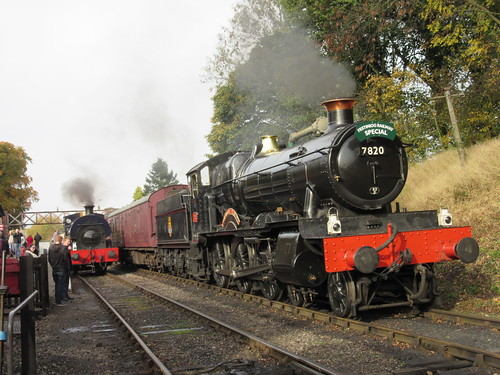 'Sir Gomer' stands in platform 1 and 7820 'Dinmore Manor' waits to take the two o'clock from platform 2.
'Sir Gomer' stands in platform 1 and 7820 'Dinmore Manor' waits to take the two o'clock from platform 2.
The 'Collett Goods', working tender first, arrived back in platform 1 in plenty of time to allow the 2 o'clock to leave 'right time'.
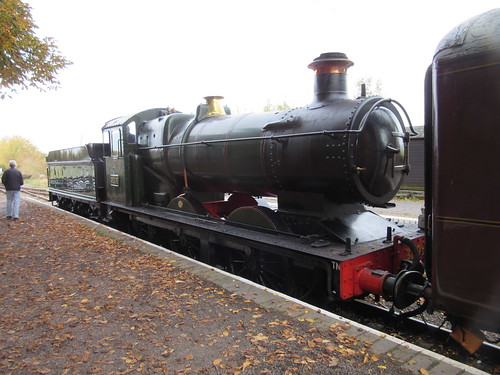 3205 Collett Goods, having left with the one o'clock is back before 2 o'clock.
3205 Collett Goods, having left with the one o'clock is back before 2 o'clock.
We then had plenty of time to take water again and couple onto the stock in platform 1. When 'Dinmore Manor' arrived back, we "got the road" for the 3 o'clock departure and, receiving the "Right Away" from the Guard, we set off on our last round trip of the day.
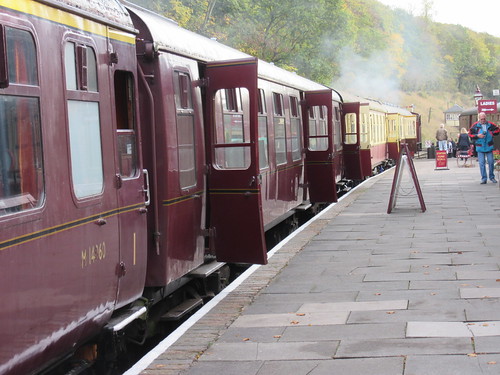 'Set 2' coaches in platform 1, with 'Cumbria' just visible at the far end, ready to take the 3 o'clock train.
'Set 2' coaches in platform 1, with 'Cumbria' just visible at the far end, ready to take the 3 o'clock train.
We had another pleasant trip, although some doubts started to be expressed as to whether we should have taken on a little more coal. You often hear talk of "sweeping the tender out" to get home and sometimes it's true. The picture below shows Jacob sweeping out our bunker. When we arrived back in platform 1 at Shackerstone, 3205 and 7820 were ready to double-head the last train of the day from platform 2.

Jacob sweeping out the bunker.
'Sir Gomer' had already disposed and moved into the shed so we knew we would have to shunt our train out of the way ourselves. After the 4 o'clock had left, we were able to run round our train using platform 2, couple onto the stock and create vacuum. Since this would be a propelling move, Danny moved to the head of the movement, to keep a look-out and give handsignals. Because of the line curvature, these handsignals were given on the left of the train to Jacob on the fireman's side of the footplate and he relayed them to me. We couldn't move the stock quite as far as we'd hoped because somebody had parked a Land Rover across the siding. Once the handbrake had been applied to the train, we uncoupled and scuttled off to the shed.
Danny had judged matters to perfection. Whilst we'd had adequate steam to complete the shunt in safety (as boiler pressure falls, the effectiveness of the locomotive steam brake is reduced) with enough steam left to fill the boiler (using the 'best' of the two injectors), there was very little fire left to require 'cleaning' and little clinker. The boiler could be left to cool naturally, minimising the stresses and reducing the chances of creating leaking tubes and stays.
The day had been dry and I understand passenger numbers had been healthy. All-in-all, an interesting and satisfying day.
Related posts on this site
'Sir Gomer'
The 'Austerity' 0-6-0ST locomotive.
All my Battlefield Line posts.
My Pictures
Battlefield Line Steam Gala, October 2015
All my Battlefield Line pictures.
[Moves in connection with coaling corrected: 4-Nov-2015]
